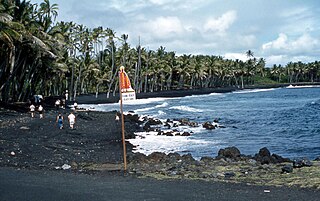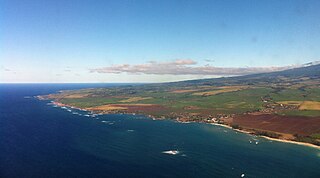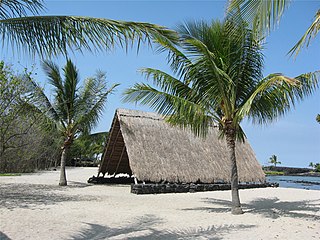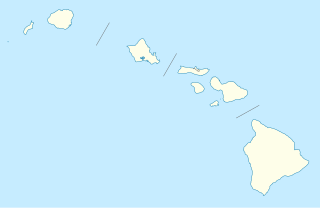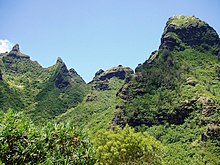
Makana is a mountain located on northern shore of the island of Kauaʻi, where it rises 1,115 feet (340 m) above Limahuli Valley. [1] Makana is a Hawaiian language term meaning gift or reward. [2] It is often used as a person's name or as part of a name. Limahuli Garden and Preserve preserves the valley below. [3] It was featured in the 1958 film adaptation of the musical South Pacific as Bali Haʻi, a name that is still used to this day. [4]
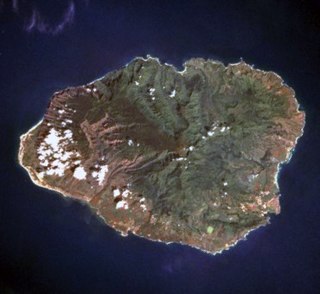
Kauaʻi, anglicized as Kauai, is geologically the oldest of the main Hawaiian Islands. With an area of 562.3 square miles (1,456.4 km2), it is the fourth-largest of these islands and the 21st largest island in the United States. Known also as the "Garden Isle", Kauaʻi lies 105 miles (169 km) across the Kauaʻi Channel, northwest of Oʻahu. This island is the site of Waimea Canyon State Park.
The Hawaiian language is a Polynesian language that takes its name from Hawaiʻi, the largest island in the tropical North Pacific archipelago where it developed. Hawaiian, along with English, is an official language of the State of Hawaii. King Kamehameha III established the first Hawaiian-language constitution in 1839 and 1840.
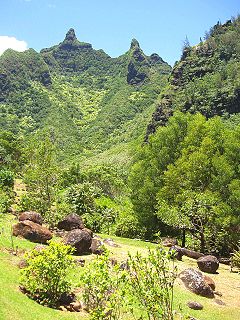
The Limahuli Garden and Preserve is a botanical garden and nature preserve on the north shore of Kauaʻi island, Hawaiʻi. It is one of the five gardens of the non-profit National Tropical Botanical Garden.
Makana Mountain is one of only two locations where the fire-throwing ceremony, ʻōahi, was performed in ancient Hawaiian times. [5] The ʻōahi was a celebration of very special occasions such as the graduation of students from the hālau hula (hula school) at Kēʻē or the visit of an aliʻi (high chief). On the day of the ceremony, skilled firethrowers climbed the steep cliffs to the very top of Makana Mountain laden with light, dry logs of pāpala ( Charpentiera spp.) or hau ( Hibiscus tiliaceus ). When night fell, they set the logs afire and hurled them out over the ocean. Ridge lifts created by trade winds hitting the sheer cliff of Makana kept the firebrands aloft, soaring as far as 1 mi (1.6 km) out to sea. The result was a night sky filled with sparks and fiery torches tracing long arcs of light. [3] It is sometimes called "Fireworks Cliff". [6]

Ancient Hawaiʻi is the period of Hawaiian human history preceding the unification in 1810 of the Kingdom of Hawaiʻi by Kamehameha the Great. Traditionally researchers estimated the first settlement of the Hawaiian islands by Polynesian long-distance navigators from French Polynesia, Tahiti, the Tuamotus and the Samoan Islands as having occurred sporadically between 300 and 800 CE. In 2010, a study was published based on radiocarbon dating of more reliable samples which suggests that the islands were settled much later, within a short timeframe, in about 1219 to 1266.
A hālau hula is a school in which the ancient Hawaiian dance form called hula is taught. The term comes from hālau, a workshed, and hula, the traditional dance of the Hawaiian Islands.

Hula is a Polynesian dance form accompanied by chant (oli) or song. It was developed in the Hawaiian Islands by the Polynesians who originally settled there. The hula dramatizes or portrays the words of the oli or mele in a visual dance form.
People in canoes would crowd the ocean below Makana, trying to catch the firebrands. It was considered heroic to catch the flaming embers, and those who succeeded would often mark themselves with the fire in honor of the occasion. Couples who caught the firebrands would both mark themselves in the same way, as a sign of love and commitment.
The practice ended in the 19th century, with the last ceremony having been in honor of Queen Emma.
